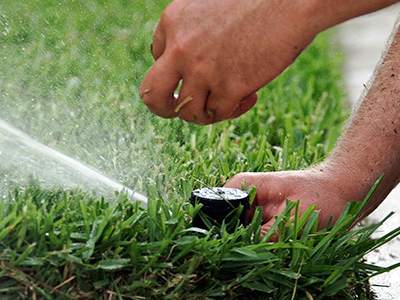Irrigation System Maintenance

Even the best irrigation system can waste water if it is run too long or operated incorrectly. You might be able to save water by regularly maintaining your irrigation system.
Test and Repair
Test your irrigation system periodically to make sure it’s operating correctly. It doesn’t matter when you do it, but you may want to schedule a time of year, like when the time changes in the spring and fall, to make sure it doesn’t slip your mind.
Make sure that all the sprinkler heads are working, and unclog or replace heads that are malfunctioning, broken, or missing. Clogged nozzles can cause dry spots in the landscape, but can often be cleaned in no time at all. Leaking lines should be repaired and old nozzles with warped spray patterns should be replaced.
Adjust Heads
Heads can be moved by collisions with feet and lawnmowers, so check them all frequently for alignment. Adjust heads so they’re watering only your landscape—not sidewalks, streets, or driveways. Sprinkler heads aimed at these surfaces waste money and water. It’s easy to twist a spray head, aligning the nozzle pattern with the plants it’s meant to irrigate. Adjust sprinkler heads to be at right angles to the soil surface. Tilted heads throw more water to one side, causing dry spots. Make sure heads pop up above the turfgrass canopy. It is not uncommon to have to raise heads a couple of times a year.
Set Controller
Set your controller (also called a clock or timer) to water only as much as plants need. Different plants have different water needs, so make sure you know how much water they should be getting before setting the controller. Change your controller settings with the seasons so you’re watering with the correct frequency. Plants tend to need less water during cooler weather, when their growth has slowed and water evaporates more slowly. Consider turning the controller off during the summer rainy season. For more information, read the EDIS publication “Operation of Residential Irrigation Controllers.”
Calibrate
You may also want to calibrate your sprinkler system to determine how much water your system is applying in a given amount of time. Many times, we’re over- or under-watering our lawns without knowing it. Calibration is an easy process that can be done by anyone.
- Gather five to ten coffee cans, tuna cans, jars, or other straight-sided containers; these will catch irrigation water. Containers that are 3 to 6 inches in diameter work best.
- a) If you have an in-ground system, place the containers in one zone at a time, scattering the cans randomly throughout the zone. (You’ll need to repeat this procedure in each zone.)
b) If you use a hose-end sprinkler to water your turf, place the containers in a straight line from the sprinkler to the edge of the watering pattern. Space the containers evenly. - Turn the water on long enough to get at least 1/4 inch in most of the containers (at least 15 minutes for spray heads and at least 30 for rotors).
- Use a ruler to measure the depth of water in each container. The more precise the measurement, the better your calibration will be. Measurements to the nearest 1/8 of an inch should be adequate.
- Find the average depth of water collected in the containers by adding up the depths and dividing by the number of containers.
- To determine the irrigation rate in inches per hour, divide minutes of run time by 60 to convert minutes to hours and then divide average inches by hours.
Now that you know your sprinkler system irrigation rate, you can apply water to your turf more efficiently. For example, if your sprinkler system applies water at the rate of 2 inches per hour (or a 1/2 inch per 15 minutes) and your grass needs up to 3/4 inches of water, then you would need to run your sprinklers about twenty-three minutes (0.75 inch/2 inch per hour=0.375hr x 60=22.5min).
Repeat
Regular irrigation system maintenance will save you money in water bills and in large repairs that result from neglecting the system. Use these tips as a guide to worry-free irrigation!
